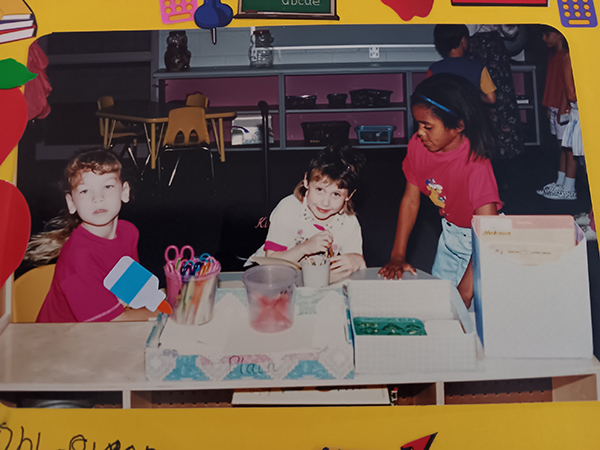Guest Post: Disability Awareness Can Be a Joyful Experience

“Having Kirsten in my classroom has been one of the most rewarding experiences of my teaching career,” my kindergarten teacher wrote to my parents in June 1996. The Americans with Disabilities Act was not quite six years old, and my teacher had “never been around a physically handicapped person” and was afraid that she couldn’t include me enough. In the same letter, she admitted, “It was unbelievable that a professional could be so scared.”
Throughout the year, my teacher discovered ways to include me. I would yell, “Get set! Go!” when other children did races, and I loved being chased in Duck, Duck, Goose when someone else pushed my wheelchair. Academic adaptations included typing my journal instead of writing it and choosing pictures from a magazine to place in “My Family” since I didn’t have the fine motor skills to draw them. When she met me, my kindergarten teacher wasn’t sure how it would work to have me in her classroom, and by the end of the year, she excitedly came up with adaptations herself. A desire to learn and getting to know me was all it took for her to be “on board” with helping me to succeed in kindergarten.
Each March, the National Association of Councils on Developmental Disabilities and its partners work together to create a social media campaign that highlights the many ways in which people with and without disabilities come together to form strong, diverse communities. The campaign seeks to raise awareness about the inclusion of people with developmental disabilities in all facets of community life, as well as awareness of the barriers that people with disabilities still sometimes face in connecting to the communities in which they live. Developmental Disabilities Awareness Month was first proclaimed by President Ronald Reagan in 1987.
I have had cerebral palsy since birth. For my whole life, I have been able to help teach people like my kindergarten teacher how to interact with someone with a disability. Not only did my teachers in school get on board, but so did my classmates. I may have been the first person with a disability that my classmates saw. I remember my kindergarten and elementary school years as wonderful because the kids actually loved to help me with small tasks in the classroom and push my wheelchair on the playground. It was a coveted spot to be the one pushing my wheelchair.
This might sound like a cliché, but an effective way to spread disability awareness is to live life. If your child has a developmental disability, help them be involved in school and community activities. It might take extra planning and effort, but it can teach those without developmental disabilities valuable lessons. Actions often speak louder than words, which is another cliché. What is also helpful in spreading awareness is to do so in natural ways. Posters and slogans can only go so far. It is everyday interactions with real people that have a lasting effect.
While there is always more to be done in our advocacy and inclusion efforts, it is interesting to look back and see how far developmental disabilities awareness has come. Prior to the early 1960s, people with developmental disabilities in the United States faced exclusion from schools, community activities, and many spheres of public and private life. Large, state-run, and often grossly underfunded and under-resourced institutional facilities were pervasive, and systemic abuse and neglect was a problem.
In 1961, President John F. Kennedy convened the President’s Panel on Mental Retardation, which developed “A Proposed Program for National Action to Combat Mental Retardation.” One of its champions was Eunice Kennedy Shriver, President Kennedy’s sister, who later founded the Special Olympics in 1968. The panel eventually proposed a legislative package with objectives regarding intellectual disabilities. Congress enacted some of these recommendations as the Maternal and Child Health and Mental Retardation Planning Amendments of 1963 and the Mental Retardation Facilities and Community Mental Health Centers Construction Act of 1963.
Numerous amendments followed, and today we have the Developmental Disabilities Assistance and Bill of Rights Act (DD Act), which was last amended in 2000. The DD Act is a federal law that provides support to states to enhance the lives of people with developmental disabilities and their families. It promotes their independence, productivity, integration, and inclusion in society.
Developmental disabilities awareness has come a long way since the 1960s. Legal protections for those with developmental disabilities have been strengthened. However, positive personal experiences with someone with disabilities are more helpful than almost anything else. As my kindergarten teacher wrote to my parents, “Thank you for being patient with me. Just be patient at the beginning of each year until a new teacher quickly learns that having Kirsten is a joy, not a chore. You don’t realize how something will work out until you do it.” Such hands-on, personal experiences are priceless. May we work toward even greater inclusion so that more people can have such experiences.

